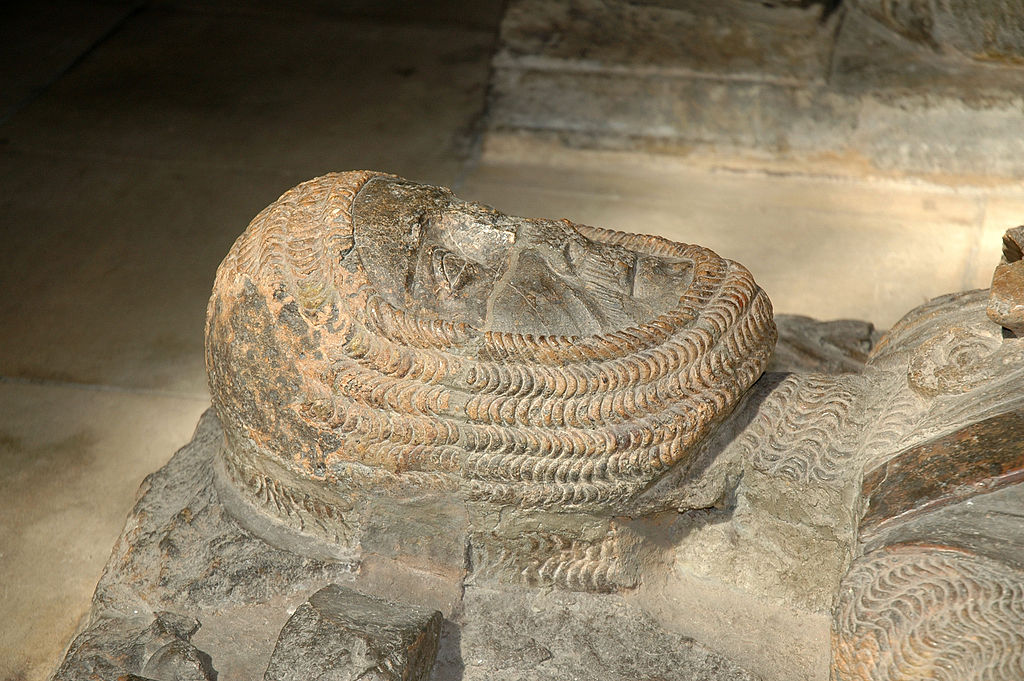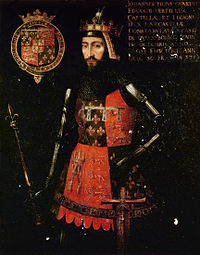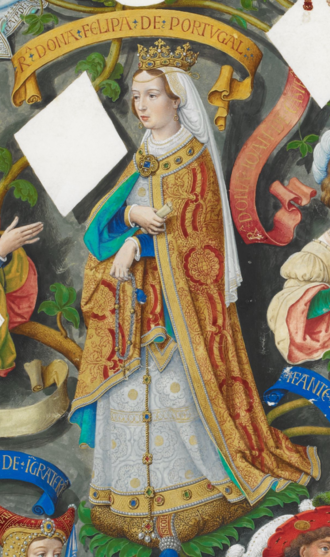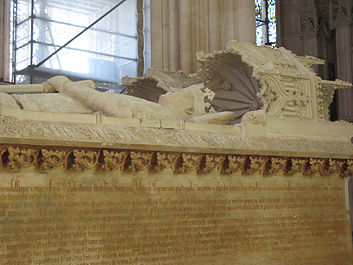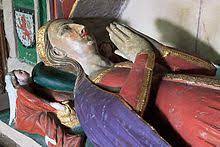Eleanor of Aquitaine is the only woman to have ever worn the crowns of both England and France. Eleanor was the ultimate survivor and, despite many setbacks, lived to a great age, revered and respected to the very end. Her life story has filled many a volume over the years; she has even been promoted as the first feminist. However, Eleanor lived within the bounds of medieval society, even if she did break the mould in many ways. Eleanor was born in the early 1120s, probably around 1122–4. Her father was Guillaume, 8th Count of Poitou and 10th Duke of Aquitaine. Her mother was Alienor, or Aenor, daughter of Aimery I, Vicomte of Châtellerault. Eleanor was one of three children; she had a sister called Petronilla and a brother, Guillaume. Little Guillaume died during childhood, shortly before the death of the children’s mother. After the death of her brother, Eleanor became her father’s heir, at least until he remarried.
Duke William died unexpectedly during Easter week 1137, while on pilgrimage to Santiago de Compostela. Eleanor was somewhere in her mid-teens at the time of her father’s death, and was not expected to be able to rule the valuable inheritance of Aquitaine alone. Just months after her father’s death, in July 1137, she was married to Louis VII of France. It is entirely possible the marriage had been planned during her father’s lifetime and brought forward due to the Duke’s untimely death. At the time of the wedding, Louis was heir to the French throne. Although he had been crowned as junior king in 1131, during his father’s lifetime, a tradition in the French royal house, a way of securing or at least signalling the succession. Shortly after the wedding on 1 August 1137, he succeeded as sole King of France, when his father, Louis VI, died of dysentery. During the years of the marriage the significance of Eleanor’s lands was highlighted by the fact Louis went by the combined title of ‘King of the French and Duke of Aquitaine’.

There seems to have been some issue concerning Eleanor’s fertility, with her first child not arriving until eight years into the marriage. There is a story that the revered abbot, Bernard of Clairvaux, had a meeting with Eleanor sometime around 1144, at St Denis, and promised to intercede with God for a son and heir to the French throne. Although Eleanor’s first surviving child was born soon after, in 1145, it was a daughter, Marie, rather than the much-desired son. The year 1144, however, also saw the fall of Edessa, far away in the Holy Land, prompting the pope to call for a new Crusade. A Crusade appealed to Louis, who was seeking atonement for an atrocity committed in his name during the invasion of Champagne, in support of Eleanor’s sister, Petronilla. Petronilla had caused scandal at the French court, by running away with Raoul of Vermandois and marrying him, despite the fact he already had a wife, the niece of the Count of Champagne. As a consequence, the two lovers were both excommunicated. However, conflict with Champagne soon followed. When Louis’ men took the town of Vitry, some 1,300 men, women and children sought sanctuary in the town’s church. Every single one of them perished when the church was burned to the ground by Louis’ marauding soldiers.
It may well be that Eleanor joined the Second Crusade in the hope that God looked favourably on her, enough to give her a son. Maybe she wanted to help her uncle, Raymond of Toulouse, who was Prince of Antioch, who had sent presents accompanied by appeals for help, to his niece and her husband. Or maybe it was Eleanor’s own desire for adventure. Whatever her reason, it was both Eleanor and Louis who took the cross at Vézelay on Easter Day, 31 March 1146, following an inspiring call to arms by Bernard of Clairvaux.
The Second Crusade proved to be the defining point of Eleanor’s marriage to Louis. Led jointly by Louis and the German emperor, Conrad III, it was an unmitigated disaster. Louis lost his personal bodyguard in the heavy defeat by the Seljuk Turks, at Laodicea, in January 1148, while still en route to Outremer. The French forces finally reached the Holy Land, arriving at Antioch, the home of Eleanor’s uncle, Raymond, just a few months later. The warm welcome and lavish attention to his niece soon brought about rumours that Raymond and Eleanor were more than niece and uncle. The persistent rumours of Eleanor’s infidelity, and incest with her uncle, led Louis to put her under close guard, despite a lack of any firm evidence of wrongdoing. She remained under such supervision – although discreetly, so as not to offend her vassals from Aquitaine, who made up a considerable part of Louis’ army. Looking at the evidence today, it is impossible to know whether the rumours, which included not just infidelity but also the birth of a child, had any foundation in truth or were merely fanciful accusations.
Louis fulfilled his pilgrimage by entering Jerusalem in 1148, making the final leg of the journey to the Holy Sepulchre, on foot and fasting, just like countless pilgrims before him. In a council at Acre, Louis and his allies then decided that the best course of action was to take Damascus, with the original aim of the Crusade – to retake Edessa – being forgotten or sidelined. However, attempts to retake the city ended in failure and Louis returned, first to Antioch and then to Jerusalem. The Second Crusade was at an end and, owing to the rumours of infidelity, Louis and Eleanor’s marriage had been dealt a fatal blow.
In 1149, Louis celebrated Easter in the Holy City of Jerusalem, before embarking at Acre for the return journey to France. Eleanor and her ladies travelled separately in another ship. They were reunited in September 1149 and were given a magnificent reception at Potenza, by King Roger of Sicily. From Sicily, they visited the pope, Eugenius III, at Tusculum. Eugenius attempted mediation in the royal marriage, going so far as to insist that they sleep together in a bed which he had personally blessed. Some temporary reconciliation must have been achieved, as their second daughter, Alix, was born within a year. However, with the failure to produce the desired male heir, a permanent reconciliation escaped them and
a divorce, on the grounds of consanguinity, was finally proclaimed during Lent of 1152.
Louis attempted to retain control of Aquitaine by insisting that he approve of any prospective husband of Eleanor’s; but the duchess rode away from the French court, and her daughters, returning to her own lands in Aquitaine in the spring of 1152. Eleanor’s marriage – and Aquitaine – was a coveted prize and her journey home was not without its perils. She is said to have narrowly escaped ambushes by the Count of Blois and Geoffrey of Anjou, second son of Empress Matilda and Geoffrey, Count of Anjou. Nevertheless, it seems likely that Eleanor had already decided her future even before her divorce was proclaimed by the clerics at Beaugency. A year earlier, Henry of Anjou and his father, Count Geoffrey, husband of Empress Matilda, had been in attendance at the French court for Henry to swear fealty for the Duchy of Normandy, and to settle disputes over the northwestern county, the Vexin. Although the Vexin issue was far from settled, Henry rode away, confirmed as Duke of Normandy and, possibly, with a promise of marriage from the soon-to-be divorced queen.
Although the marriage of Henry and Eleanor is often presented as a love-match, it was a marriage of hardheaded practicality with mutual benefits. Eleanor needed a husband who was strong enough to stand up to Louis. As Duke of Normandy and Count of Anjou, and with the possibility of the crown of England tantalisingly close, Henry was the ideal choice as Eleanor’s new husband. They were married in Poitiers Cathedral in May 1152; Eleanor was around thirty years old and Henry was nineteen. Louis was furious and called Henry to court to explain himself for having married without the permission of his liege lord. When Henry failed to appear, Louis formed a coalition against him, persuading King Stephen to attack Normandy from England, while he attacked from the south. Stephen was keen to oblige, hoping to secure the English succession for his son, Eustace, and neutralise the threat posed by Henry. Louis’ other allies included Thibault of Blois, recently betrothed to Alix, the two-year-old daughter of Louis and Eleanor; and Henry of Champagne, who was now married to seven-year-old Marie, Louis and Eleanor’s eldest daughter, and Eleanor’s heir to Aquitaine, at least until Eleanor and Henry had a son.
Louis had thought Henry was preoccupied with plans for invading England. Instead, he quickly reacted to the French king’s aggression, conducting a lightning campaign, which caught Louis off guard. The French king was completely outmanoeuvred and was quick to acquiesce when the Church called for peace. Henry
could then turn his attention to England, which he invaded in However, the death of Stephen’s oldest son and heir, Eustace, in August of that year ultimately led to the Treaty of Winchester, with Stephen bypassing his youngest son, William, in order to settle the succession on Henry and bring to a close the twenty years of warfare, known as the Anarchy. When Stephen died the following year, Henry’s accession followed peacefully. Henry and Eleanor were crowned, together, in a magnificent ceremony in Westminster Abbey, on 19 December 1154. They now ruled an empire that stretched from the borders of Scotland in the north, to the borders of Spain in the south.
By the time of her marriage to Henry, Eleanor had already survived the birthing chamber on at least two occasions, with the births of her daughters, Marie and Alix, by Louis VII. Although she had only produced two children in fifteen years of marriage to Louis, by the time of her coronation Eleanor had already provided Henry with a son and heir, William, born in August 1153. William died in England in 1156, aged just three, with his mother by his side, and his father away in the family’s Continental domains. However, he had already been joined in the nursery by another son, Henry, born in February 1155, and a daughter, Matilda, who was two months old when little William died. Childbirth was a dangerous time for women, with no guarantee that having survived once, twice or three times, you would survive a fourth or fifth confinement. Nevertheless, after William’s death, Eleanor safely delivered another five children into the world. Her favourite son, Richard, who was her choice as heir to Aquitaine, was born in September 1157 and another son, Geoffrey, who became Duke of Brittany when he married the duchy’s heiress, Constance, arrived twelve months later. Eleanor, who would become Queen of Castile, was born in October 1162, and Joanna, who would initially marry the King of Sicily and then Raymond VI of Toulouse, arrived in October 1165. Eleanor’s fifth son, and tenth and last child, John, was born at Christmas, 1167. Having given birth to ten children over the course of twenty-two years, Eleanor had survived the most perilous aspect of any medieval woman’s life. She would have been well aware of the risk she was taking every time she entered the birthing chamber, knowing that either she or the baby, or both, may not survive.
During their married life together Henry was constantly on the move, travelling between his vast domains, dealing with restless barons, dispensing justice and holding court. Eleanor joined him when she could, depending on her state of pregnancy or recent childbirths. In 1156, for example, still grieving for her three-year-old son William, Eleanor crossed the English Channel with her surviving son, eighteen-month-old Henry, and daughter Matilda, when Matilda was just two months old, journeying to join Henry in Anjou, before moving on to Aquitaine in October. Travel had its own dangers; the English Channel is not the calmest of sea roads and Henry’s own uncle, William, son and heir of Henry I, had been killed in the White Ship tragedy in 1120, when his ship had foundered leaving harbour, killing all but one of the people on board.
Land journeys could be equally hazardous. Indeed, Eleanor was almost kidnapped or killed in April 1168, when travelling through the hills of Poitou, escorted by Patrick, Earl of Salisbury, and his men. The party were ambushed by Eleanor’s rebellious vassals, Geoffrey and Guy de Lusignan. Salisbury and his men were travelling, unarmoured, when the de Lusignans fell upon them. The earl ‘sent the Queen on to the castle’ at Poitiers while he and the remainder of his men held off the attackers, giving the queen time to make it to safety. The earl was killed by a lance during the vicious skirmish; his nephew, William Marshal, was wounded in the thigh and captured after having his horse killed under him. William spent several months in captivity, his wounds healing despite the harsh treatment meted out by the de Lusignans. William was a young, penniless knight and was finally released when Queen Eleanor agreed to pay his ransom. William then joined the queen’s household, before joining that of her son, Henry. William Marshal would faithfully serve five English kings – Henry II, Henry, the Young King, crowned during his father’s lifetime, Richard I the Lionheart, King John and, finally, Henry III, for whom the aged Marshal was regent.
The years 1169 to 1173 were spent, almost exclusively for Eleanor, in her duchy of Aquitaine with her son, Richard, who she was training as her eventual successor. Richard was invested as Count of Poitou and, in 1169, paid homage to Eleanor’s first husband, King Louis, for the Duchy of Aquitaine. In 1173, however, news reached Henry II that his sons were plotting against him. The boys – now men – were tired of frequently having the possibility of power and responsibility dangled before them, only for their father to withdraw it at the last minute. Henry’s eldest son, Henry, the Young King, fled to the court of Louis VII, his father-in-law since his marriage to Louis’ daughter, Marguerite, in 1160. For unknown reasons, Eleanor sided with her sons against their father. It was later suggested that Eleanor had been incensed at Henry’s relationship with Rosamund Clifford – the Fair Rosamund – and that, wounded by this betrayal, had joined or incited her sons’ rebellion.
There is, in fact, no contemporary evidence that the affair caused Eleanor’s rebellion and her reasons remain obscure. She may have resented the restrictions of power placed on her, or the fact Henry would not allow their sons any exercise of power. Whatever the reason, Eleanor joined the rebellion, and lost. Her sons were outmanoeuvred and defeated by Henry. Far from humiliating them, however, Henry came to terms with his sons and an uneasy peace ensued. On the other hand, Henry was not so forgiving of Eleanor, who was captured while trying to escape Poitou; she had tried to reach the safety of the French court, dressed in men’s clothing. In 1174, Henry sent his queen to imprisonment in England, possibly at Salisbury, under heavy guard.
Eleanor was kept securely at first, but her imprisonment was relaxed as the years passed, especially after the death of her son, Henry, the Young King, who had pleaded with his father from his deathbed in 1183, that his mother be treated less harshly. In subsequent years, Eleanor was allowed at court for some ceremonial occasions, and was allowed visits by her daughter, Matilda, who had been exiled with her husband, Henry of Saxony, from their German lands. Matilda was instrumental in getting the restrictions eased even further and, although she was still in the custody of guards, Eleanor was allowed to reside with Matilda at various locations in England, including Windsor and Berkhamsted. However, fifteen years of imprisonment in England, far away from her homeland and court in Aquitaine, cannot have been easy for a queen used to riding freely across the vast domains she and her husband possessed.
The queen was only released after Henry’s death in 1189; indeed, ordering his mother’s release was one of the first acts of her son, Richard I. And the queen was there to welcome him for his ceremonial entry into Winchester in August 1189. Now in her mid-sixties, Eleanor was given a new lease of life, and lived it
with the same energy and vigour she had in the years before her imprisonment. Almost immediately, Eleanor was trusted with the oversight of the government of England. In 1190 she travelled to Navarre, to collect Richard’s bride, Berengaria, and deliver the princess to her son, then en route to the Holy Land on the Third Crusade. After a winter journey over the Alps, the queen, now almost seventy, escorted Berenagria to a rendezvous with Richard at Messina in Sicily in March 1191. Having fulfilled her mission, Eleanor set off home, almost immediately; although not before what must have been an emotional reunion with her youngest daughter, Joanna, who was Queen of Sicily and had been widowed in November 1189, but held prisoner by her husband’s successor, Tancred. Richard affected her release and his sister was now to be a companion for his bride; Joanna accompanied Richard and Berenagria to the Holy Land.
Eleanor was later instrumental in securing her son’s release from captivity in Germany. Richard had been captured by Leopold V, Duke of Austria, on his return journey from the Holy Land, in December 1192. He was handed over to the Holy Roman Emperor, Heinrich VI, in March 1193. During Richard’s captivity, Eleanor was inexhaustible in her attempts to raise the ransom, some 150,000 marks and to keep her son, John, in check. John took the opportunity created by Richard’s absence to make a play for power; he and Philip II Augustus, King of France, went so far as to offer Heinrich 80,000 marks to keep Richard incarcerated. John was still in open opposition to his brother when Eleanor finally secured Richard’s release, on 4 February 1194. Eleanor travelled to Germany to personally hand over the ransom payment and escort Richard home. As news of Richard’s release reached England, John fled to France.
Richard’s death in April 1199, must have come as a horrific blow for Eleanor; the loss of her favourite son, at just forty-one years of age, caused immense grief. Richard’s death was soon followed by that of Joanna, Eleanor’s youngest daughter, who, heavily pregnant and hurt, had sought refuge with her mother at Rouen. Eleanor was by her daughter’s side as she gave birth to a son, Richard, who lived only long enough to be baptised. Joanna died within moments of her son, in September 1199, and mother and baby were buried together at the Abbey of Fontevrault.
Having lost four of her children in quick succession – her two daughters with Louis, Alix and Marie, also died in 1197 and 1198, respectively – and with her youngest son, John, now on the English throne, Eleanor undertook one final, diplomatic mission. Nearing her eightieth year, Queen Eleanor journeyed across the Pyrenees to Castile, in search of a bride for Louis, the dauphin of France and grandson of her first husband, Louis VII. England’s Dowager Queen was received at the court of Alfonso VIII and her own daughter, Eleanor, Queen of Castile, with all the pomp and pageantry the Castilians could muster. She stayed there for more than two months, taking the opportunity to spend some time with her daughter and getting to know her granddaughters. Eleanor of Aquitaine seems to have decided that twelve-year-old Blanca would make a more suitable bride for Louis than her sister, Uracca. Eleanor then brought Blanca back to France and delivered her to her bridegroom, Louis; the couple were married in Normandy, as France was under papal interdict at the time, owing to the marital indiscretions of Louis’ father, King Philip II Augustus.
Following her delivery of Blanca to her new husband, Eleanor retired to the Abbey at Fontevrault. She did not take the veil as a nun, but lived in her own house within the abbey’s precincts. However, the eighty-year-old queen had one final adventure in 1202, when she was besieged by her fifteen-year-old grandson, Arthur, Duke of Brittany, at Mirebeau. Arthur had rebelled against his uncle, King John, and made an attempt on the English throne. In a remarkable forced march, John quickly came to his mother’s rescue, capturing Arthur and his sister, Eleanor, and raising the siege. Arthur disappeared into King John’s dungeons at Rouen and probably died there during Easter, 1203. His sister, Eleanor, was sent to England, to a perpetual, if comfortable, imprisonment.
The event was Eleanor’s last major adventure; increasingly frail, she retreated to Fontevrault, where she died on 31 March 1204, aged around eighty-two. She had outlived all but two of her children, with only Eleanor in Castile, and John in England, still living. She was buried in the abbey church alongside her second husband, Henry II, and her son, Richard, and daughter, Joanna. Eleanor of Aquitaine had survived the Second Crusade, several kidnap attempts, fifteen years of imprisonment and giving birth to ten children. She was the most remarkable woman of the medieval age, the ultimate survivor and a heroine to the core.
*
Images:
Courtesy of Wikipedia
Sources:
.Jane Martindale, Eleanor, suo jure Duchess of Aquitaine (c.1122–1204) (article), Oxforddnb.com; Douglas Boyd, Eleanor, April Queen of Aquitaine; The Plantagenet Chronicles, edited by Elizabeth Hallam; Mike Ashley, The Mammoth Book of British Kings & Queens; Thomas Abridge, The greatest Knight; Mary Anne Everett Green, Lives of the Princesses of England from the Norman Conquest; Alison Weir Britain’s Royal Families, the Complete Genealogy; Robert Bartlett England Under the Norman and Angevin Kings; Alison Weir Eleanor of Aquitaine, by the Wrath of God, Queen of England; britannica.com; geni.com; royalwomenblogspot.co.uk; medievalqueens.com; Brewer’s Royalty by David Williamson
*
My Books:
Signed, dedicated copies of all my books are available through my online bookshop.
Out Now: Women of the Anarchy
On the one side is Empress Matilda, or Maud. The sole surviving legitimate child of Henry I, she is fighting for her birthright and that of her children. On the other side is her cousin, Queen Matilda, supporting her husband, King Stephen, and fighting to see her own son inherit the English crown. Both women are granddaughters of St Margaret, Queen of Scotland and descendants of Alfred the Great of Wessex. Women of the Anarchy demonstrates how these women, unable to wield a sword, were prime movers in this time of conflict and lawlessness. It show how their strengths, weaknesses, and personal ambitions swung the fortunes of war one way – and then the other.
Available for pre-order from Amberley Publishing and Amazon UK.
Coming on 15 June 2024: Heroines of the Tudor World
Heroines of the Tudor World tells the stories of the most remarkable women from European history in the time of the Tudor dynasty, 1485-1603. These are the women who ruled, the women who founded dynasties, the women who fought for religious freedom, their families and love. These are the women who made a difference, who influenced countries, kings and the Reformation. In the era dominated by the Renaissance and Reformation, Heroines of the Tudor World examines the threats and challenges faced by the women of the era, and how they overcame them. Some famous, some infamous, some less well known, including Anne Boleyn, Elizabeth Barton, Catherine de Medici, Bess of Hardwick and Elizabeth I. From writers to regents, from nuns to queens, Heroines of the Tudor World shines the spotlight on the women helped to shape Early Modern Europe.
Heroines of the Tudor World is now available for pre-order from Amberley Publishing and Amazon UK.
Also by Sharon Bennett Connolly:
King John’s Right-Hand Lady: The Story of Nicholaa de la Haye is the story of a truly remarkable lady, the hereditary constable of Lincoln Castle and the first woman in England to be appointed sheriff in her own right. It is is available from Pen & Sword Books, bookshop.org and Amazon. Defenders of the Norman Crown: The Rise and Fall of the Warenne Earls of Surrey tells the fascinating story of the Warenne dynasty, from its origins in Normandy, through the Conquest, Magna Carta, the wars and marriages that led to its ultimate demise in the reign of Edward III. Available from Pen & Sword Books, Amazon in the UK and US, and Bookshop.org.
Ladies of Magna Carta: Women of Influence in Thirteenth Century England looks into the relationships of the various noble families of the 13th century, and how they were affected by the Barons’ Wars, Magna Carta and its aftermath; the bonds that were formed and those that were broken. It is now available in paperback and hardback from Pen & Sword, Amazon, and Bookshop.org. Heroines of the Medieval World tells the stories of some of the most remarkable women from Medieval history, from Eleanor of Aquitaine to Julian of Norwich. Available now from Amberley Publishing and Amazon, and Bookshop.org. Silk and the Sword: The Women of the Norman Conquest traces the fortunes of the women who had a significant role to play in the momentous events of 1066. Available now from Amazon, Amberley Publishing, and Bookshop.org.
Alternate Endings: An anthology of historical fiction short stories including Long Live the King… which is my take what might have happened had King John not died in October 1216. Available in paperback and kindle from Amazon.
Podcast:
Have a listen to the A Slice of Medieval podcast, which I co-host with Historical fiction novelist Derek Birks. Derek and I welcome guests, such as Bernard Cornwell and Elizabeth Chadwick, and discuss a wide range of topics in medieval history, from significant events to the personalities involved.
*
Don’t forget! Signed and dedicated copies of all my books are available through my online bookshop.
For forthcoming online and in-person talks, please check out my Events Page.
You can be the first to read new articles by clicking the ‘Follow’ button, liking our Facebook page or joining me on Twitter and Instagram.
©2022 Sharon Bennett Connolly FRHistS




